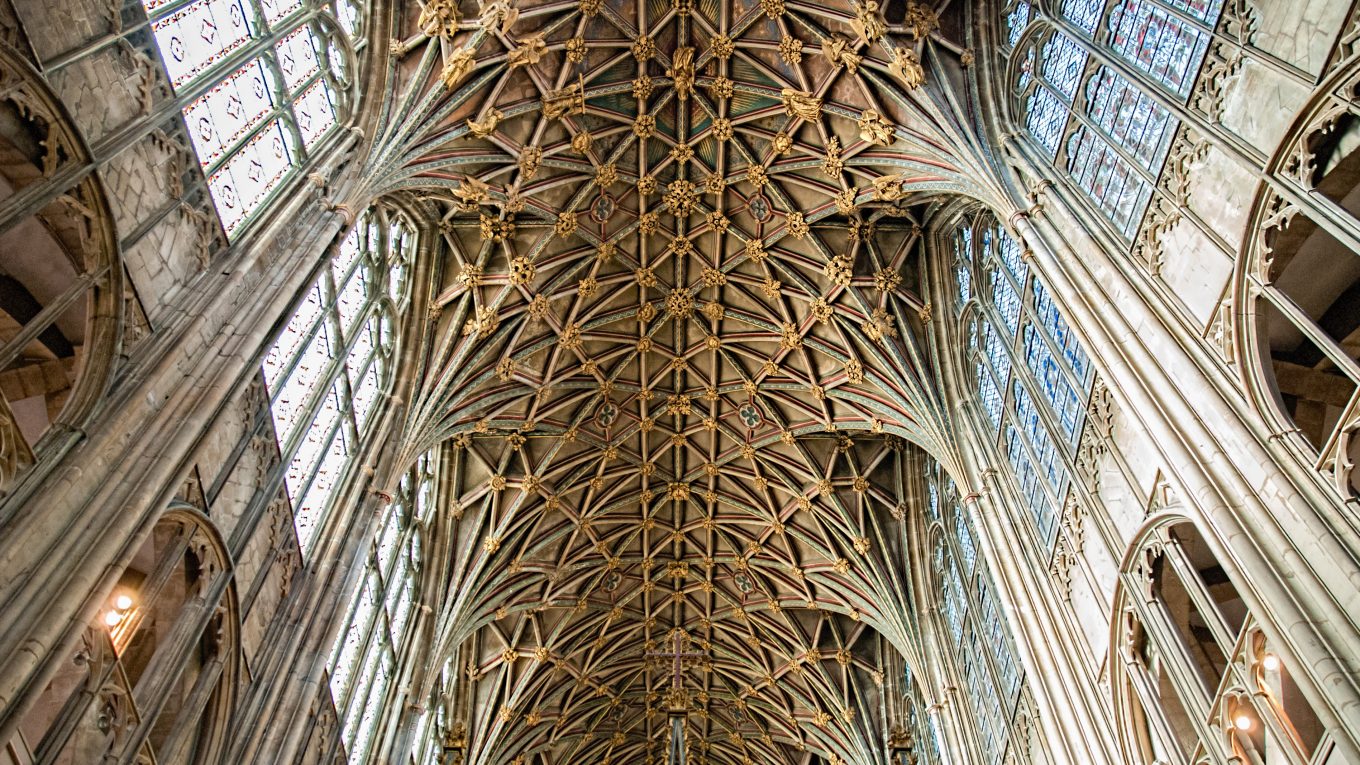Top 25 Examples of Gothic Architecture
During the later period of the Middle Ages, one style dominated European building: The Gothic Style. Gothic Architecture was popular for hundreds of years, particularly in the powerful kingdoms of Western Europe in modern-day England, France, and Spain. There are many trademark features in Gothic Architecture such as pointed arches, stained glass windows, and tall soaring towers and naves. European builders during the Gothic Age utilized many innovative forms of technology in order to build bigger, better, and more detailed monuments which are still seen by awestruck visitors every day.
What is Gothic Architecture?
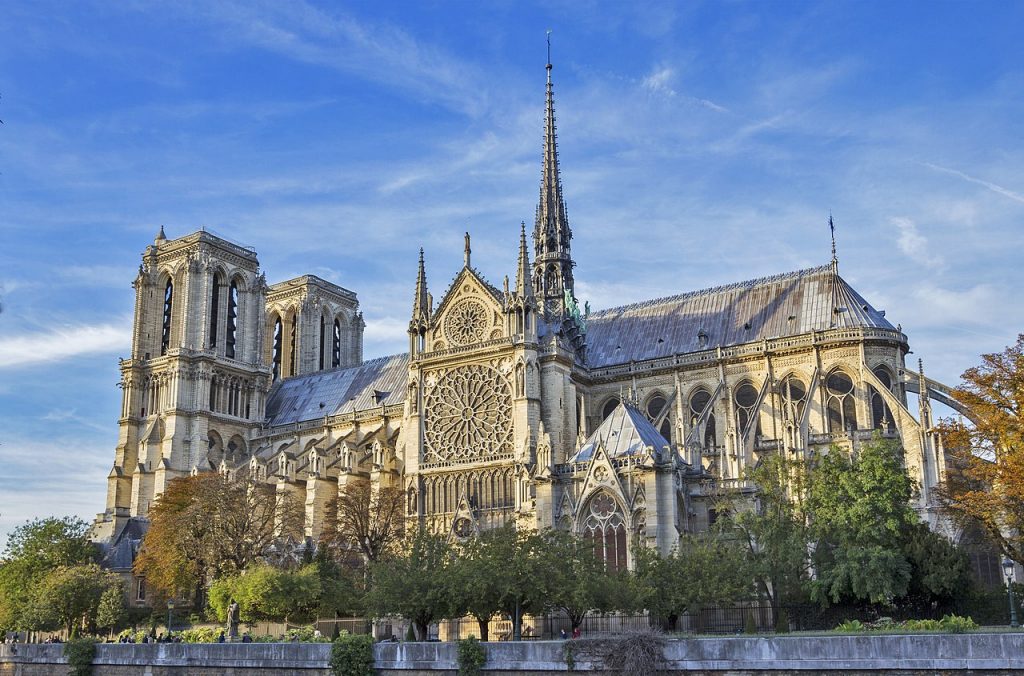
Gothic Architecture was a style that dominated the buildings of Europe from the 12th-16th centuries. With a heavy concentration in France, England, Spain, and Germany, the Gothic Style evolved gradually from the earlier Romanesque style. Pointed arches, Rose Windows, Flying Buttresses, and stained glass are all key features of the Gothic Style. Although the most impressive Gothic buildings were religious structures, Gothic Architecture can be seen in many different forms such as palaces, fortifications, and government buildings.
When was the Gothic Period?
The Gothic Period Lasted from the 12th century until the 15 century. Below is a timeline of how Gothic Architecture fits in with other major architectural styles.
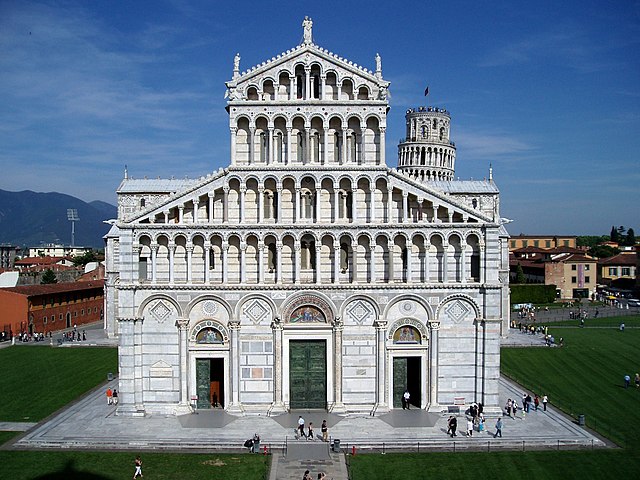
Romanesque Architecture
10th century – 12th century
Before the Gothic Age, there was the Romanesque Age, which emerged in Europe at the end of the Dark Ages, beginning in the 900s. Romanesque buildings tend to be shorter & boxier than their Gothic counterparts.

Gothic Architecture
13th century – 14th century
Gothic Architecture would become Europe’s dominant building form by the early-1200s. By the mid-1300s Gothic structures were reaching new heights, becoming some of the largest & tallest buildings on earth.
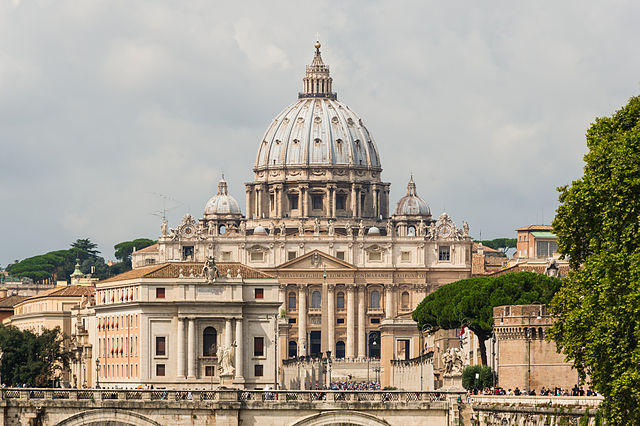
Renaissance Architecture
15th century – 16th century
Eventually, the Italian Renaissance movement would emerge in the city of Florence in the early-1400s. By the mid-1500s century Renaissance Architecture would become popular throughout all of Europe.
Periods of Gothic Architecture
Gothic Architecture was a constantly evolving style. In the 1100s it started out more simplistic, before becoming the high-flying form of building that we see in the late middle ages. You can break this transformation down into three major phases: Early Gothic, High Gothic, and the Flamboyant Gothic Period. Below you will see three examples of different French churches that show the evolution of this style.
Early Gothic Architecture
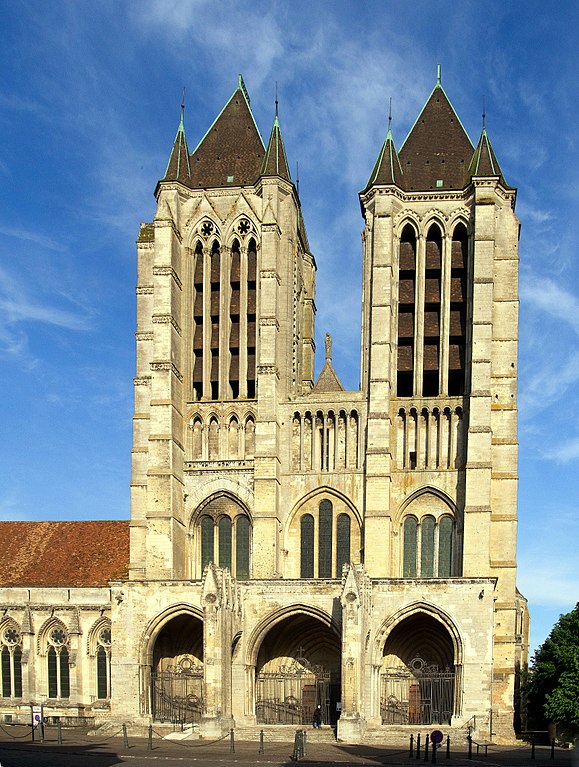

At the very end of the Romanesque Era, certain churches within France started utilizing some of the elements found in the Gothic Era. Most of the architecture in Noyon Cathedral dates from 1130-1150, although many additions were added later on. On the front facade, you can start to see the pointed arches taking shape, although they are still stubby and fatter-looking than later Gothic Arches. The buttresses that support the roof over the apse of the church are still technically “Flying Buttresses” but they don’t really create a lot of separation from the building. These buttresses barely resemble the elegant and graceful Flying Buttresses found in later Gothic Buildings.
High Gothic Architecture


Eventually, builders in Europe started getting more daring, They pushed the limits of buildings by improving on the flying buttress design. Here at Reims Cathedral, the roof is supported by much larger buttresses than what was found in Early Gothic Buildings. The arches connect to columns that are several feet from the exterior walls, and then those columns transfer the loads to the ground. The Facade of Reims Cathedral also combines a Rose Window, Pointed Arches, and intricate detailing to create one of the most famous Gothic Elevations in all of France.
Flamboyant Gothic Architecture
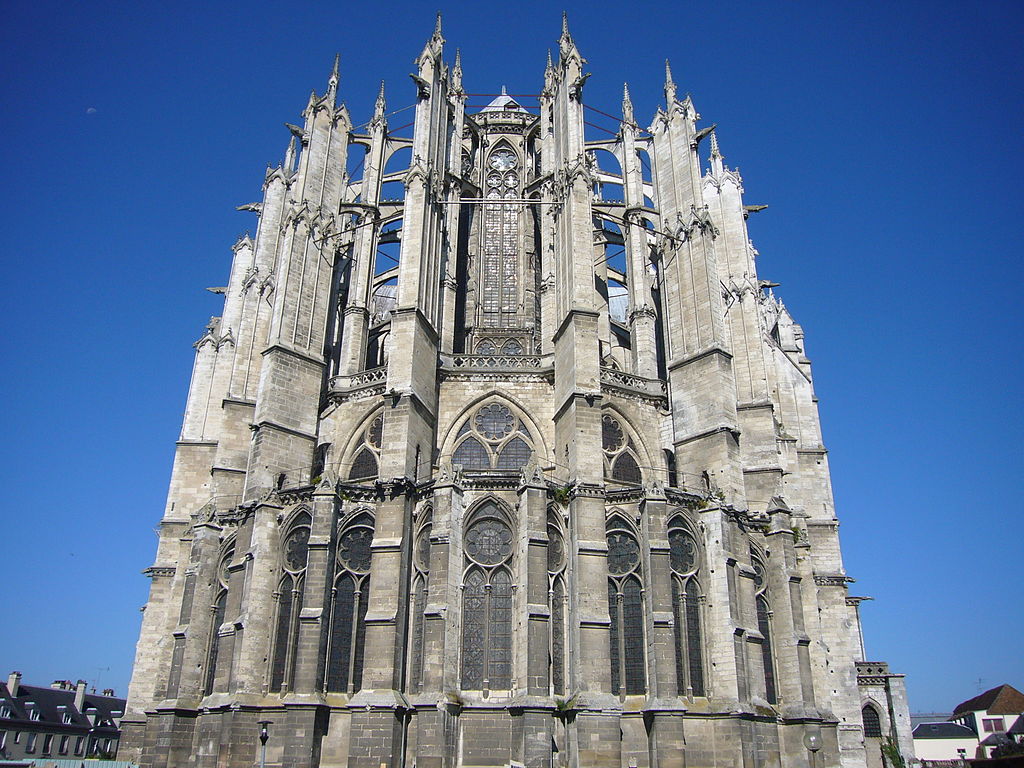
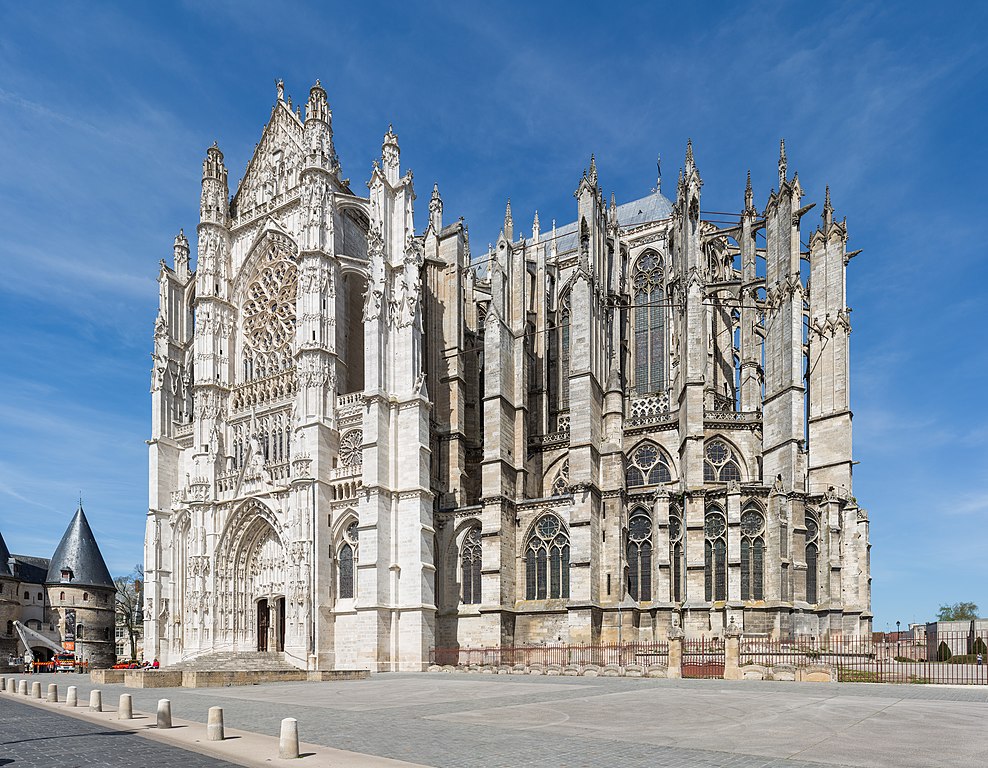
In the final phase of the Gothic Period, architects got even more audacious with their plans. The greatest example of this is Beauvais Cathedral, which contains the world’s tallest church nave at 154 feet (46m). Here the flying buttresses are just massive pillars that are only tethered to the exterior walls by tiny strands of stone that almost disappear when you look from far away. But the ambitious design of the church was its downfall, and Beauvais Cathedral was never completed. The only reason it stands intact today is because of numerous modern restoration projects which added in structural steel.
Characteristics of Gothic Architecture
Pointed Arches

Stronger and more elegant than the round arch, the pointed arch is the most defining element of Gothic Architecture. The Carmo Convent in Lisbon was mostly destroyed in the Great Lisbon Earthquake of 1755, but many of the Gothic Arches survived, which shows the lasting strength of this architectural feature. These arches were strong enough to not only hold their own weight, but also the weight of the massive vaulted ceiling above. Although many believed the pointed arch was invented during the Gothic Age, it actually dates from much older forms of Islamic Architecture. Many historians believe that the pointed arch made its way to Western Europe from the Moors, an Islamic group that ruled much of the Iberian Peninsula in the Middle Ages.
Stained Glass

Stained glass is an integral part of nearly all Gothic Architecture, particularly in religious buildings. Stained glass was an essential part of the catholic church’s plan to teach the stories of the bible to a largely illiterate European population. The stained glass windows at Chartres Cathedral in France are some of the most impressive in all of Europe. The blue pieces of glass were renowned in the Middle Ages for being extremely expensive to produce. Patrons of the church spent excessive amounts of wealth creating these stained glass windows, which feature countless pieces of blue stained glass.
Flying Buttresses
Photo by Qaalvin from Wikimedia Commons
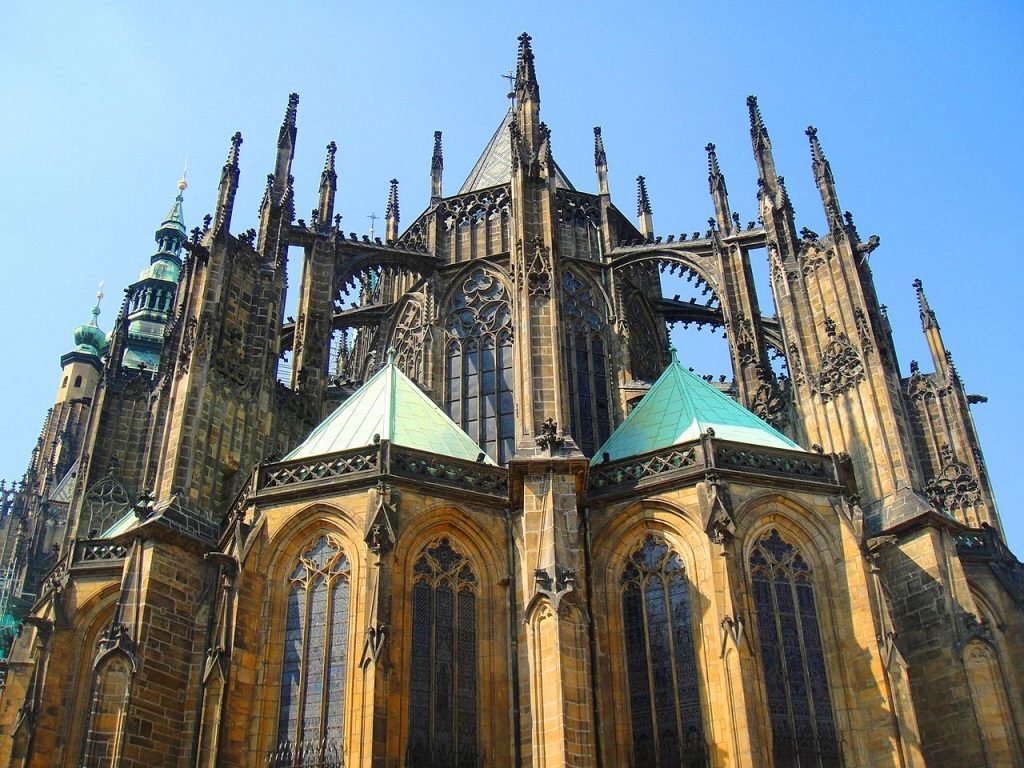
One of the most important technical innovations from the Gothic Age was the Flying Buttress. While a regular buttress had been used prior, the flying buttress was an adaptation that helped spread the load of the roof outward down the stone arches and columns. Since the buttresses were taking the weight of the roof, the walls of Gothic Cathedrals were able to become thinner and filled with stained glass, which brought more natural light inside. This innovation is one of the key elements that separates Gothic buildings from earlier Romanesque Buildings. The Apse of St. Vitas Cathedral in Prague has several Flying Buttresses that are intricately decorated with pinnacles and spires, which was common in the late Gothic era.
Rose Windows
Photo by Guilhem Vellut from Wikimedia Commons

Rose Windows are another iconic feature of Gothic Architecture. Found all over buildings from this time period, the Rose Window always remains the same design, a circular window with wheel-like segments to divide the pieces of glass. This Rose Window at Strasbourg Cathedral is one of the most intricate and complex examples from the Gothic Age. The thin pieces of stone found throughout the front facade of the church are a marvel of medieval craftsmanship.
Vertical Emphasis
Photo by Taxiarchos228 from Wikimedia Commons

One final element that can be seen throughout the Gothic Buildings of Europe is vertical emphasis, with lots of towering forms and spaces that are disproportionately tall when compared to their floor area. Palma Cathedral in Spain has one of the tallest naves ever constructed during the Gothic Age, and the church’s entire design revolves around this soaring central space. The arms race to build taller and taller buildings led to several world records during the gothic age. The tallest church tower in the world is at Ulm Minster, a Gothic Church in Germany, and the tallest nave on Earth is at Beauvais Cathedral in France. The striking heights that Gothic Builders were able to achieve were thanks in large part to new innovations, like the Flying Buttress. The towering heights were meant to inspire the populations of Europe, making them awestruck at the power of the Christian Church.

Before the age of Gothic Architecture, Romanesque was Europe’s dominant architectural style. Read our article, “Romanesque Architecture and the Top 15 Romanesque Buildings” to learn more!
Romanesque vs. Gothic
Romanesque Architecture came before Gothic Architecture. The Romanesque period lasted from the 6th-12th century, while the Gothic Period lasted from the 13th-16th century.

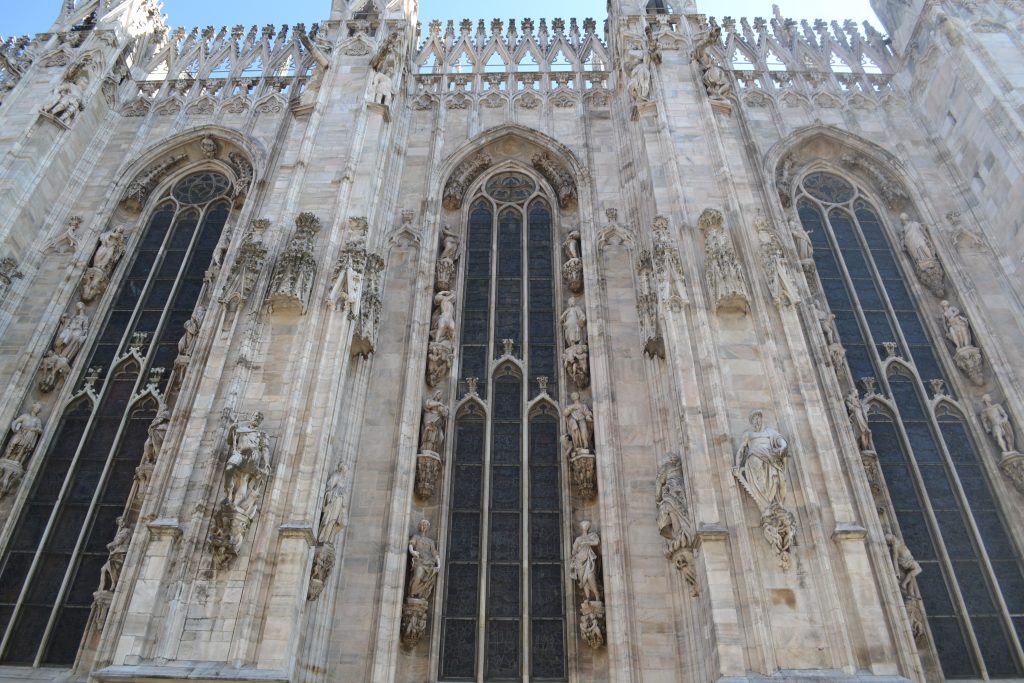
- (left) Rounded arches at Speyer Cathedral in Germany
- (right) Pointed arches at Milan Cathedral in Italy
- Right Photo by © José Luiz Bernardes Ribeiro / CC BY-SA 4.0
There are many differences between the two styles. A lot of these differences have to do with European history during the middle ages. Technology was advancing, and people were able to build larger more graceful buildings during the Gothic Period.
New building techniques like the pointed arch and the flying buttress allowed architects to build taller and larger structures. The buttresses allowed the weight of the roof to be spread outward with the help of the pointed arches.
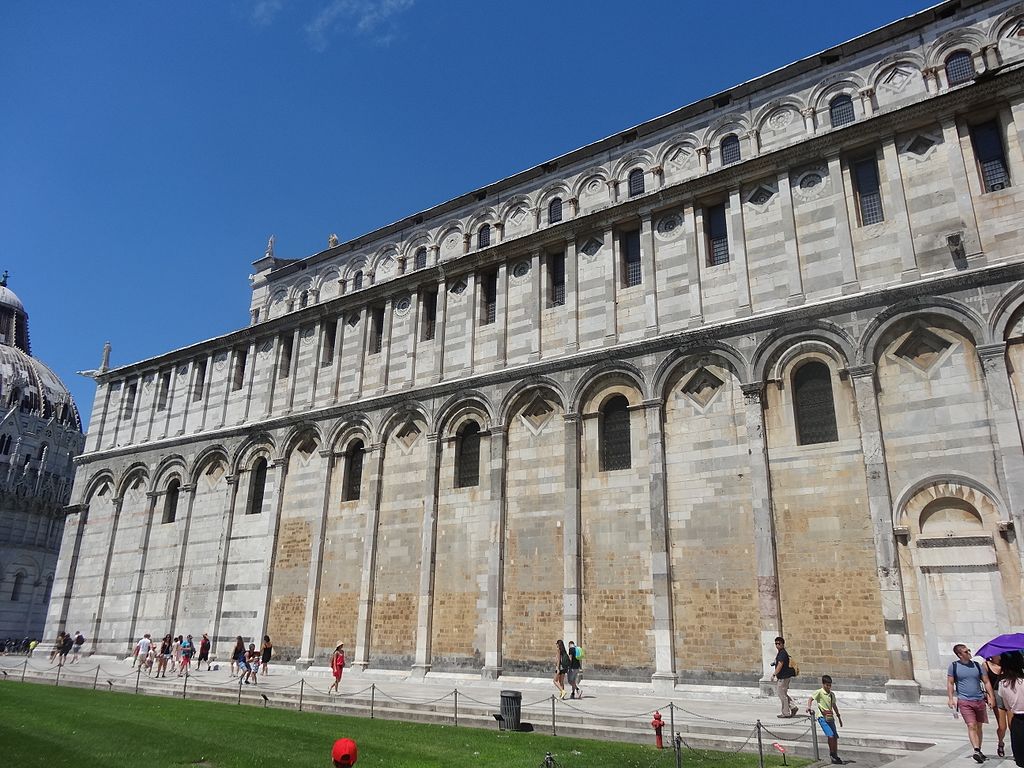
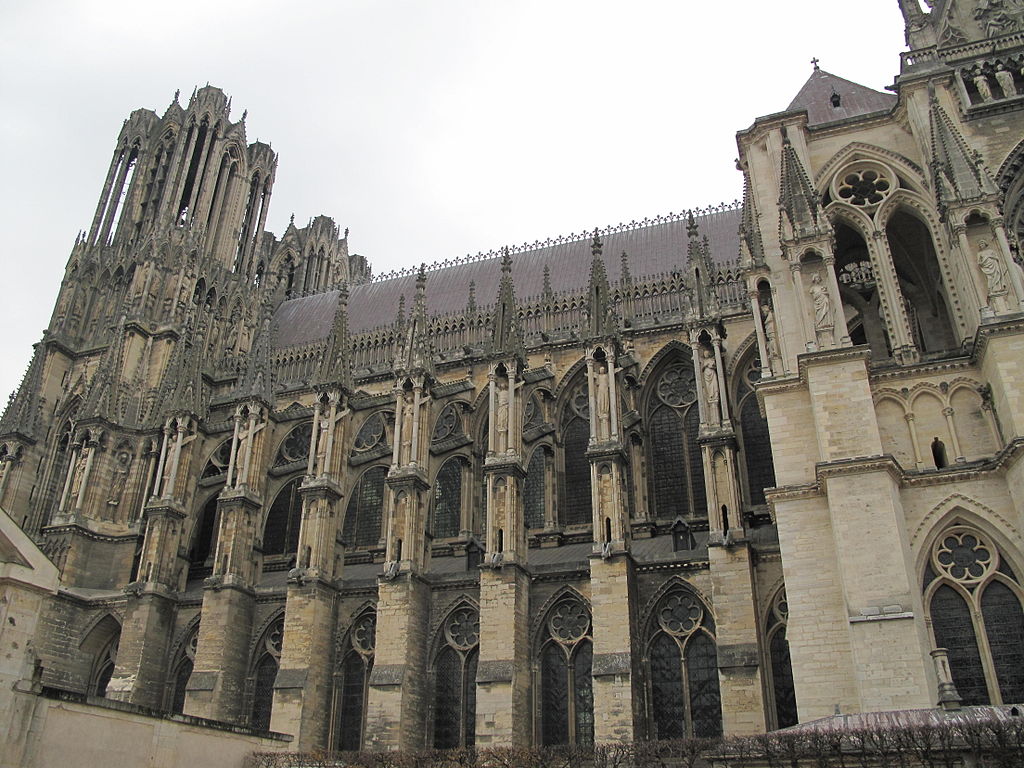
- (left) Side of Pisa Cathedral, with flat walls that have small windows with round arches
- (right) Side of Reims Cathedral, with flying buttresses which allow for huge windows with gothic arches
- Left Photo by Jordiferrer from Wikimedia Commons
Instead of having thick stone walls with tiny windows to support your roof, like in a Romanesque building, you could use the buttresses to take the weight of the roof. This allowed architects to construct massive stained glass windows that would let incredible amounts of light into the interior space.

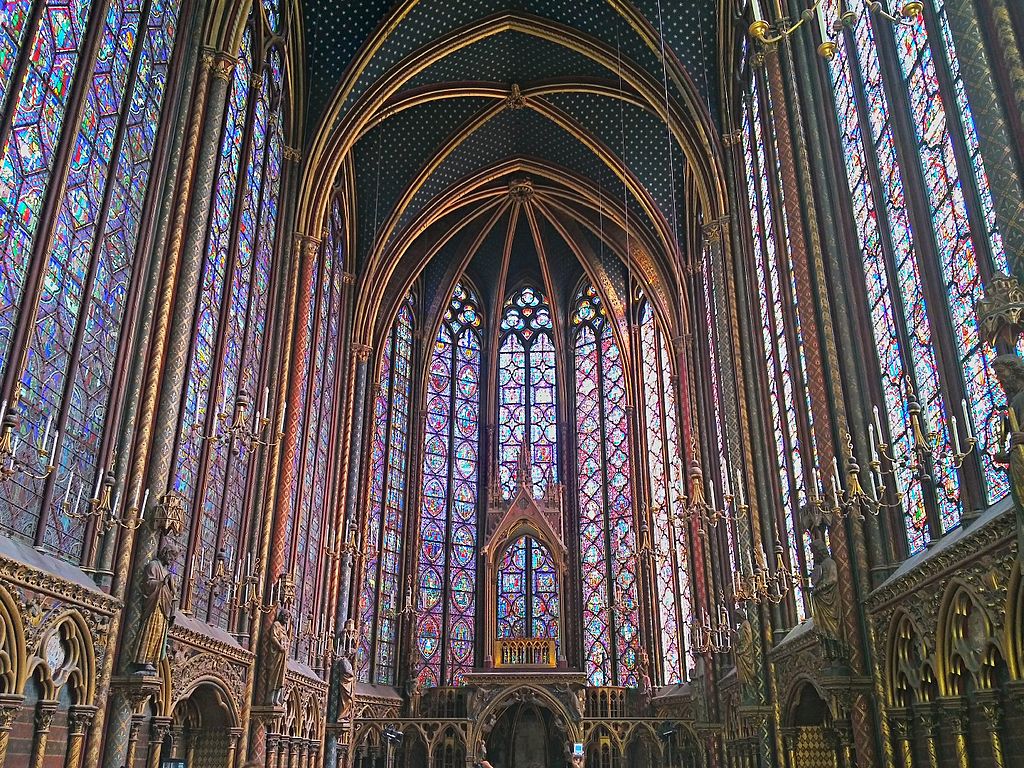
- (left) The interior of Vézelay Abbey in Vézelay, France. Notice the vaulted ceiling, rounded arches, heavy windows with a lack of natural light, and the lack of excessive detail and artwork.
- (right) The interior of Sainte Chappelle in Paris, France. Notice the ribbed ceiling, the pointed arches, and the massive stained glass windows filled with intricate artwork.
- Left Photo by Jörb Bittner Unna from Wikimedia Commons
- Right Photo by Artmch from Wikimedia Commons
Romanesque architecture also does not include the copious amount of detail that you find in Gothic architecture. Below you will see some simple geometric stonework in a Romanesque church, compared to the elaborate carvings in a Gothic building.
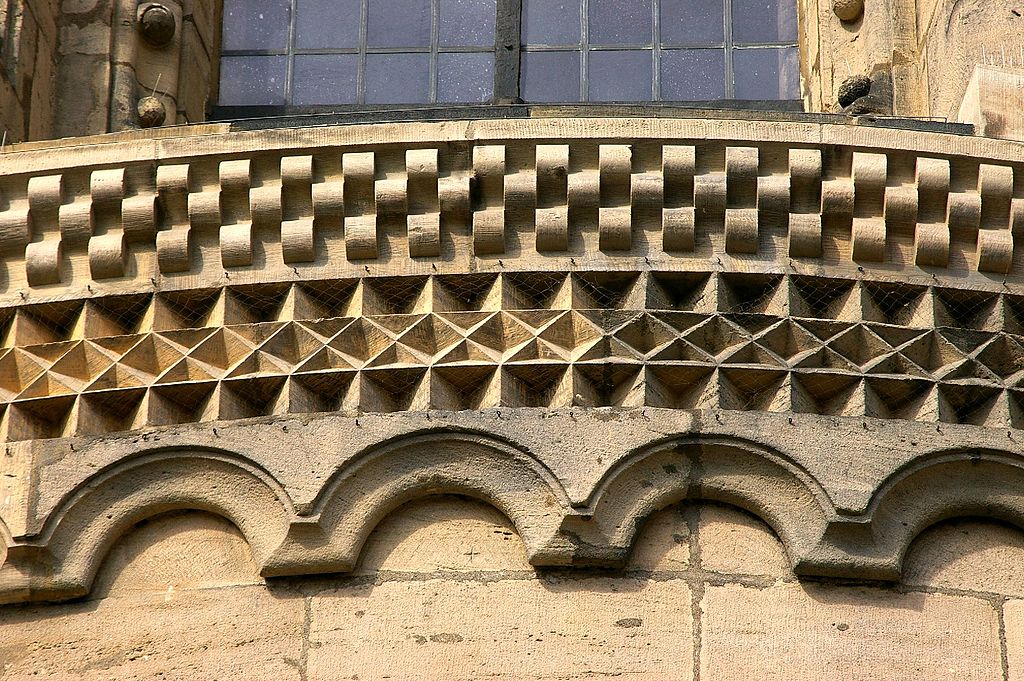
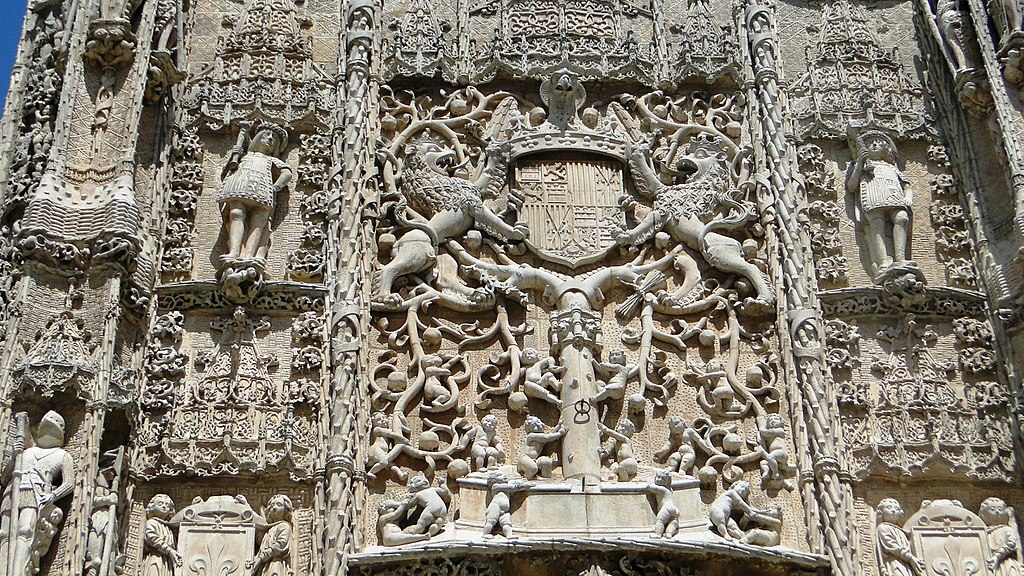
- (left) Romanesque detailing at Bamberg Cathedral in Bramber, Germany
- (right) Late Gothic detailing at the Colegio de San Gregoria in Valladolid, Spain
- Left Photo by Reinhard Kirchner from Wikimedia Commons
- Right Photo by Rafael Tello from Wikimedia Commons
Again, the discrepancies in the detailing had a lot to do with European history. Religious authorities in the middle ages were often opposed to excessive art and details, as they were thought to distract from the services of the church. Eventually, these practices were slowly abandoned, and art was made more openly, so long as it told the message of the church and the bible.
It’s scaled back, but in Romanesque architecture, you can see fine details and carved stonework. You will find stories from the bible, depicted mostly around column capitals and within the Tympanum, the main archway above the entrance to a church. Gothic architecture took this a step further and showed even more intricate depictions of various religious motifs.

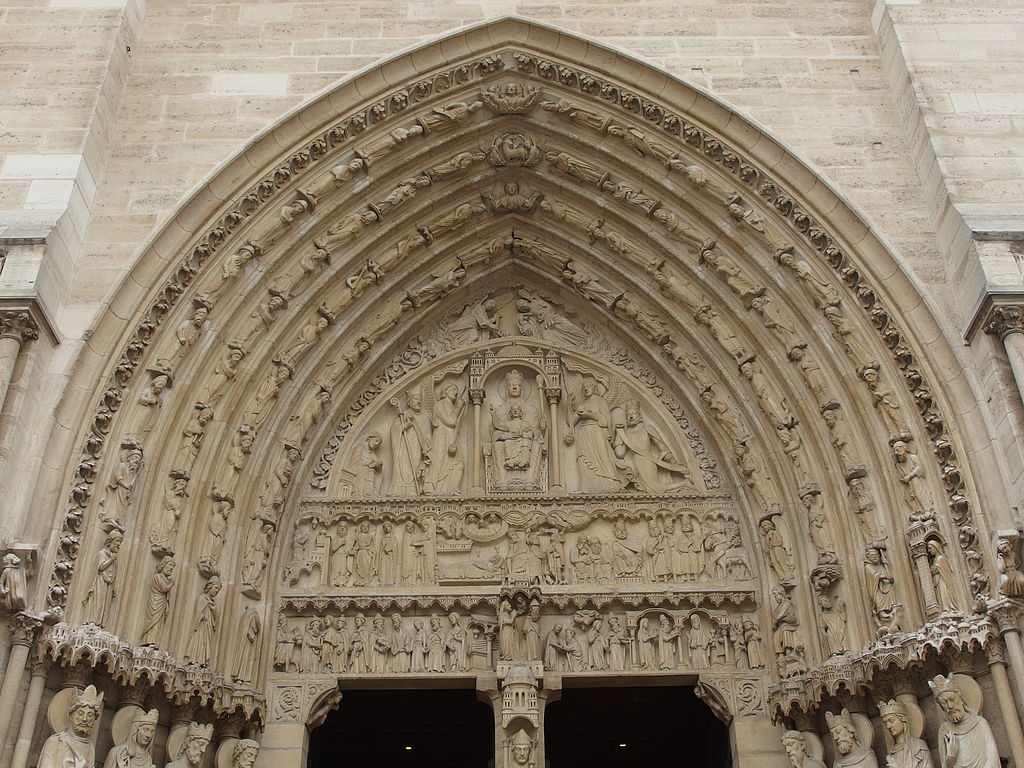
- (left) Tympanum at Vézelay Abbey in Vézelay, France
- (right) Tympanum at Notre Dame in Paris, France
- Both carvings depict the scene of the last judgment, however, the Gothic version is much more intricate and detailed, with significant improvement in the realism of the sculpture. The carvings also leave the area of the Tympanum and cascade down and around the doorway and into the rest of the building.
- Left Photo by Gerd Eichmann from Wikimedia Commons
- Right Photo by Guilhem Vellut from Wikimedia Commons
What are the best examples of Gothic Architecture?
Below is a list of buildings that are often regarded as the best examples of Gothic Architecture. These buildings show all of the key features of the Gothic style.
Rather than just focusing on churches, this list will also incorporate secular buildings as well to give a cohesive look at Gothic Architecture. This list will focus on size, innovation, and overall beauty to determine what are the best Gothic buildings that can still be found in Europe today.
1. Strasbourg Cathedral – Strasbourg, Grand Est, France

Strasbourg is a city in France just over the Rhine River from France’s border with Germany. Both nations controlled Strasbourg at various points in history, leaving behind a blend of French and German culture that remains in the region to this day. The Cathedral of Strasbourg contains a few elements of Romanesque Architecture, such as the transept at the south end of the church which was built in the early 13th century. But the majority of the church is completely Gothic. The entire front facade, the bell tower, the nave, and all of the stained glass date to the late 13th-15th century. Strasbourg even held the title of “Tallest Building on Earth” from 1647 to 1874, after the collapse of another church’s belltower in 1647.

One of the most striking elements of the building is the highly decorated front facade. The intricate stonework is unlike that of any other Gothic Cathedral. There are columns that are only a few inches wide precariously placed all over the front of the building. Around all of the windows and at the tops of most of the arches there are lacy and fragile shapes, delicately carved by skilled masons. Its astounding that the cathedral is in such good condition, considering the tumultuous history of Strasbourg over the past few centuries, which has only been apart of France since 1919 after WWI and the Treaty of Versailles.
2. St. Vitas Cathedral – Prague, Czech Republic
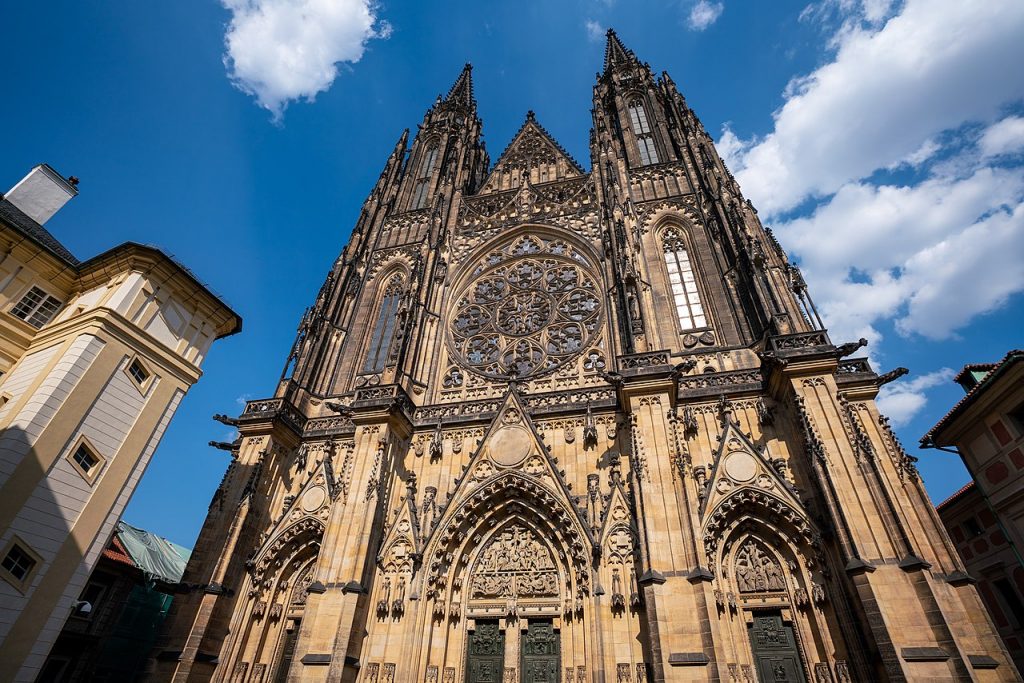
St. Vitus Cathedral is one of those churches in Europe that was still being modified after hundreds of years. Starting out as a very early stone church in the 10th century, construction on the Gothic portion began in 1344. It wasn’t until 1929 that the final elements of the church were completed, including some stained glass windows designed by the renowned Czech painter, Alphonse Mucha. The images in the stained glass have a distinct Art Nouveau influence, and they are a unique example of this type of art within a Gothic building.

St. Vitas Cathedral sits within the center of Prague Castle, a massive complex of palaces, religious buildings, and fortifications, that sits across the Vltava River from the old town of Prague. The entire complex is listed as a UNESCO World Heritage Site along with several other notable buildings within Prague. St. Vitas Cathedral remains an icon of the city, and it has helped Prague earn the nickname, “The City of 100 Spires.”
3. Seville Cathedral – Seville, Andalusia, Spain

Seville Cathedral is the largest church built during the Gothic Age. After the Moorish Conquest of the Iberian Peninsula in the early 8th century, Seville remained an Islamic city until it was recaptured by the Kingdom of Castile in 1248 during the Reconquista. When Seville was controlled by the Moors, the rulers constructed a magnificent mosque, complete with a minaret known today as the Giralda. When the Christians recaptured the city they demolished the mosque, destroying everything except for the Giralda, which survived to become Seville Cathedral’s bell tower.
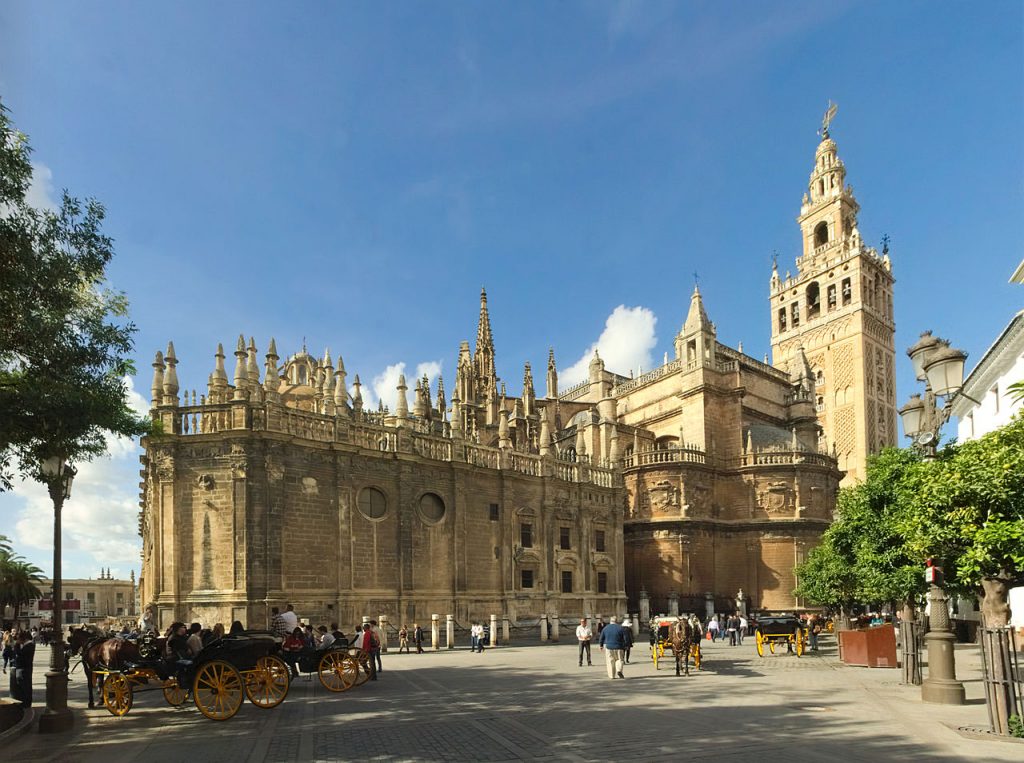
The rulers of the city planned for their cathedral to be the largest ever built in Europe. The bulk of the construction took place from 1434-1517, and the cathedral features all of the distinct elements of Gothic Architecture such as pointed arches, stained glass, flying buttresses, and a rose window. Today along with several other important sites in Seville, the Cathedral is listed as a UNESCO World Heritage Site.
4. Gloucester Cathedral – Gloucester, England, United Kingdom
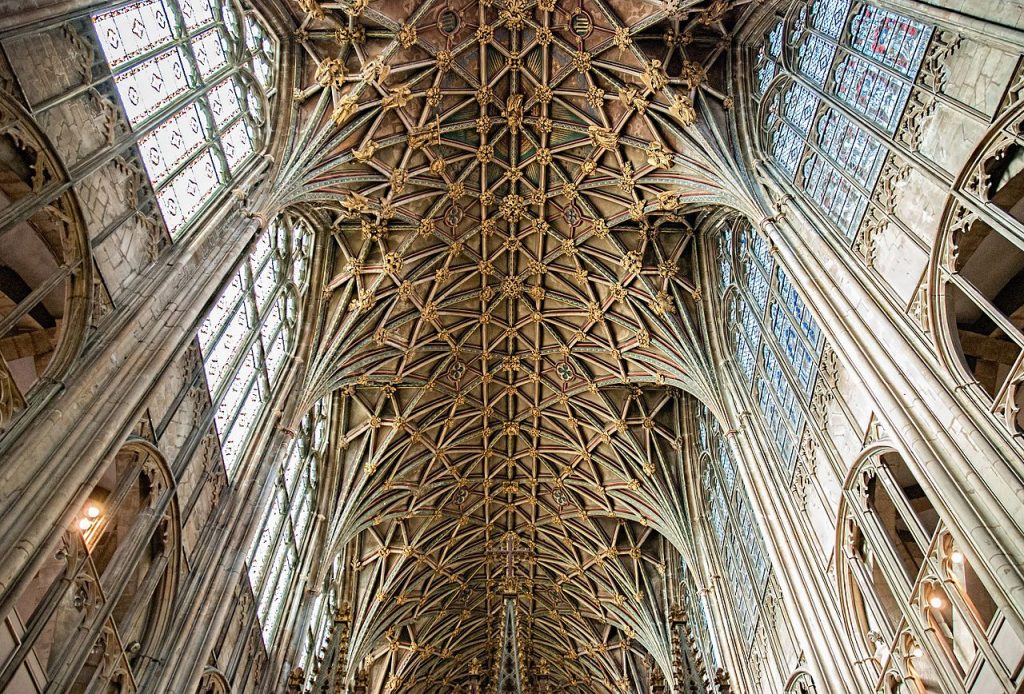
Gloucester is a city founded by the Romans on the banks of the Severn River in South West England. The cathedral sits near the banks of the river and is the city’s most well-known site. The original structure dates to the 11th century during the time of the Normans. Although some of the inner portions of the church were built during the Romanesque Age, most of the architecture is in a distinctly Gothic style.
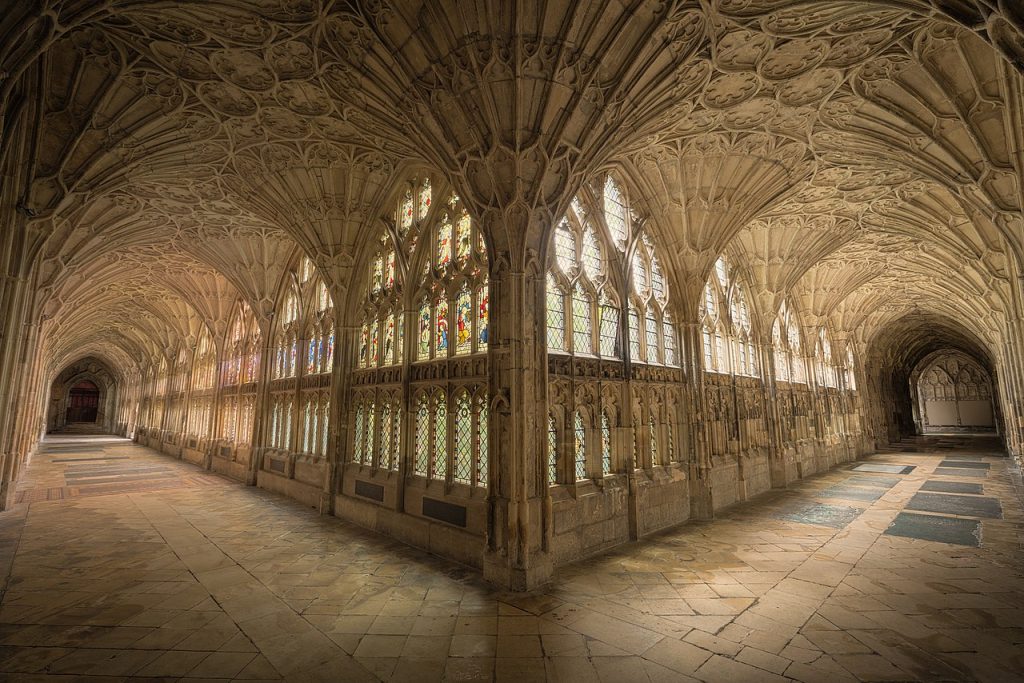
The towering ceilings above the high altar are ornately carved with stone ribs and are 86 feet (26 m) above the floor. But it’s the fan-vaulted ceilings in the cloister that are by far the most impressive features of Gloucester Cathedral. The intricately carved stone detail almost look as if they are organic, like vines sprouting up from the walls onto the ceiling. These incredible hallways have been a popular filming location over the years thanks to their striking appearance,
5. Chartres Cathedral – Chartres, Centre-Val de Loire, France

Chartres Cathedral is located 50 miles (80 km) from Paris and is one of Europe’s greatest Gothic Cathedrals. The nave is 121 feet (37 m) tall, and the taller of the two towers measures 371 feet (113 m) tall. Completed in the early 13th century, Chartres Cathedral was built in the first part of the Gothic Age. The city of Chartres has a very well-preserved medieval center, so the church and its surroundings look the same as they did centuries ago.

The most emblematic feature of Chartres Cathedral is its numerous stained glass windows. The stained glass at Chartres was made by some of the finest craftsmen of the Middle Ages. Thousands of precisely cut pieces of glass were combined to create images of saints and stories from the Bible. Today, Chartres Cathedral is listed as a UNESCO World Heritage Site.
6. Milan Cathedral – Milan, Lombardy, Italy
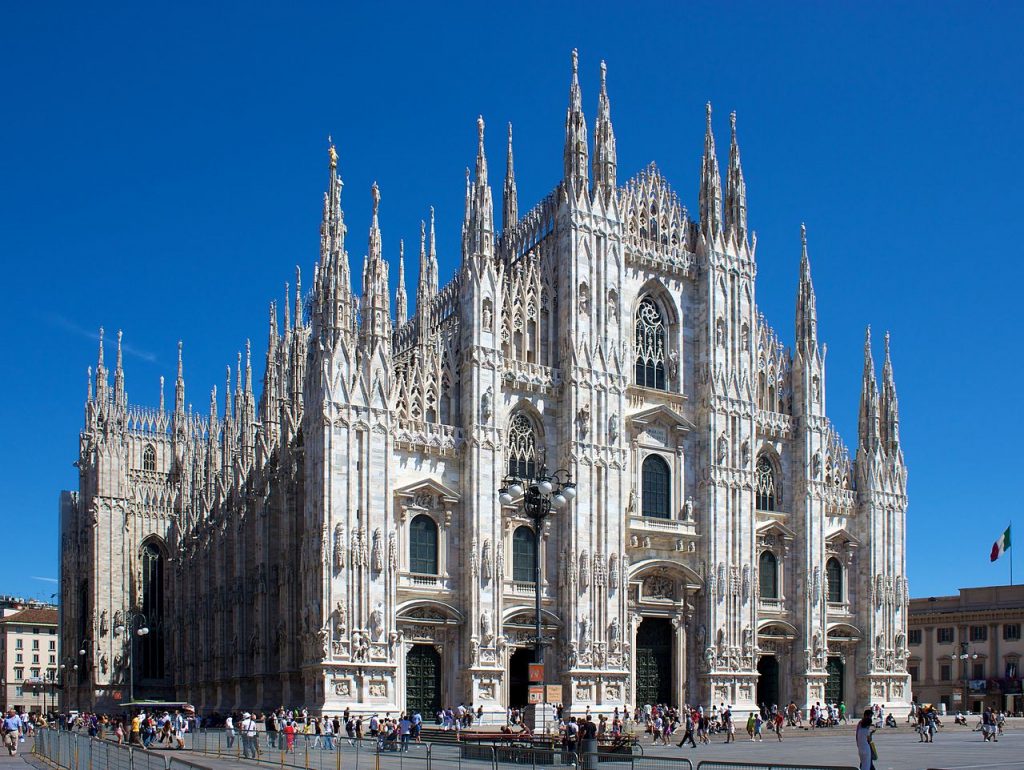
Milan Cathedral is the second-largest church on the Italian Peninsula after Saint Peter’s in Vatican City. The church is one of the most visited sites in the modern bustling city of Milan. Located fronting the Piazza del Duomo, the church is also right next to the popular Galleria Vittorio Emanuele II. While Milan Cathedral was mostly built with Gothic Architecture, there are still elements from other periods, such as the pediments above the windows on the front facade. These pediments were typical in Renaissance Architecture. Although construction on the cathedral began in the 14th century, the finishing touches weren’t completed until 1965, which explains the building’s more eclectic components.
Like Architecture of Cities? Sign up for our mailing list to get updates on our latest articles and other information related to Architectural History.
7. Sainte-Chapelle – Paris, Île-de-France, France

While the Sainte-Chapelle isn’t a record-breaker in terms of its size, it’s still one of the greatest works of Gothic Architecture ever built. Construction lasted less than 10 years, and the church was consecrated in 1248. Rather than trying to build ever taller and larger spaces, the builders of the chapel wanted to focus on an extremely well-crafted and ornately detailed space for royal ceremonies and religious services. The walls of the chapel seem to be mostly glass, with only thin widely-spaced columns between the large pointed archways.
8. King’s College Chapel – Cambridge, England, United Kingdom

Built in the final stages of the Gothic Age, the Chapel at King’s College is considered one of the finest examples of late Gothic Architecture. King Henry VI himself specified the dimensions for the chapel. Construction began in the late 15th century and the final stained glass window was completed in 1531. The chapel’s central aisle is nearly 300 feet (91 m) long and has a fan-vaulted ceiling running the entire length. Today, King’s College Chapel is one of the focal points of the campus of the University of Cambridge.
9. Notre-Dame de Paris – Paris, Île-de-France, France

Notre Dame, which translates to “our lady,” is a popular title for French churches dedicated to the Virgin Mary. Although you will find many different “Notre Dames” throughout France, the most famous is Notre-Dame de Paris, located in the French capital city. Notre Dame sits on the banks of the Seine River, on the larger of the two Parisian islands known as Île de la Cité. Sadly, the church was badly damaged during a fire in April 2019. Most of the lead-covered wood roof, as well as the church’s iconic central spire, were completely destroyed. (The above photo was taken before the fire.) Today there is an ongoing restoration project to rebuild Notre-Dame de Paris in its original form.
10. Palais des Papes – Avignon, Provence, France

The Papal Palace of Avignon is one of the finest examples of Palatial Gothic Architecture in Europe. Although the vast majority of impressive buildings from the Middle Ages were religious, other buildings were built in the Gothic style too, like castles and palaces. The Papal Palace is a bit of both. Known in French as the Palais des Papes, the building dates to a time when the Pope lived in the city of Avignon in Provence, France. Although the Papacy wouldn’t remain in Avignon, the monuments built by the Popes did. The building was designed to be not only a lavish residence for the leaders of Catholicism but also a fortified castle to protect them. That is why the building is complete with defensive towers and ramparts, as well as banqueting halls and bed chambers.
11. Cologne Cathedral – Cologne, North Rhine-Westphalia, Germany

Cologne Cathedral famously survived the bombs of WWII to remain the second tallest church in the world, after another church in Germany, Ulm Minster. Although technically a lot of the church wasn’t built during the Gothic Age, the builders still mostly followed the original design. A large portion of the cathedral was built during the 13th-16th century, but it wasn’t until 1880 that Cologne held an opening ceremony to commemorate its completion. Although the 19th-century portion follows the original design from the Middle Ages, many modern techniques of Masonry construction were introduced, such as iron structural supports to support the stone.
12. Amiens Cathedral – Amiens, Hauts-de-France, France

Amiens, a town straddling the Somme River in Northern France, is one of many French towns containing a remarkable Gothic cathedral. Amiens Cathedral was built in a relatively short time frame of 50 years from 1220-1270. Because the church was completed so quickly, it is distinctly High Gothic, with all of the usual elements of a 13th-century cathedral. The front has two asymmetrical bell towers that surround a massive rose window. Now a UNESCO listed site, the cathedral brings thousands of visitors to Amiens every year.
13. Lincoln Cathedral – Lincoln, England, United Kingdom

Although it can’t be proved, many historians argue that Lincoln Cathedral was once the tallest structure ever built after its central tower was completed in 1311. Unfortunately, the central spire atop the tower collapsed in the 16th century, dethroning the church as the world’s tallest building. Despite the collapse of the tower, the church is still one of the most vertically impressive in England. The vaulted ceilings in the nave and the three towers all contribute to the building’s immense height. The interior of Lincoln Cathedral is well-known for the different varieties of ceiling vaults that can be found in various parts of the building.
14. St. Stephen’s Cathedral – Vienna, Austria
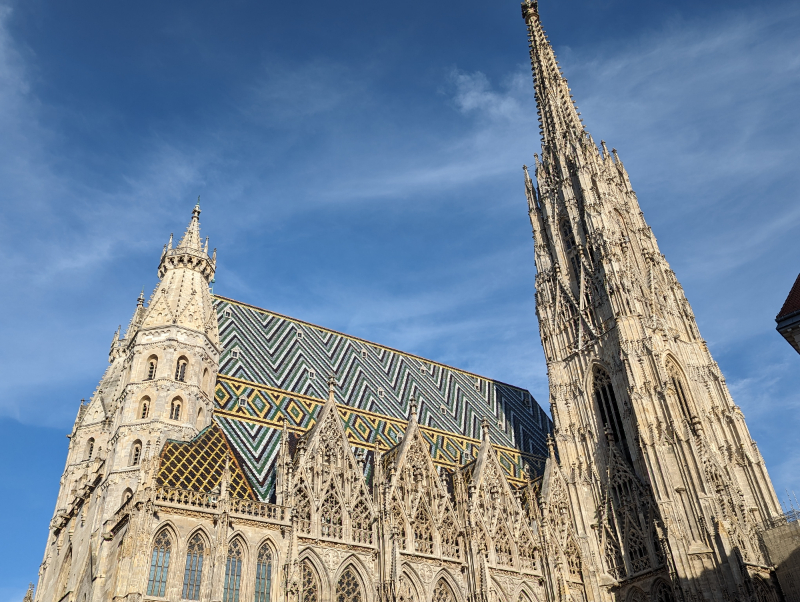

Vienna, the former capital of the once-mighty Hapsburg Empire, was a leading city in central Europe during the Middle Ages. Saint Stephen’s Cathedral is Vienna’s most important church and is a testament to the complex history of the city. Like a lot of cathedrals of the era, the church was built over centuries, with construction starting and stopping sporadically. The cathedral features two Romanesque towers, which were built prior to the Gothic nave. The South Tower was the tallest structure in the city for hundreds of years, and work was started on a similar North Tower but was never completed. The decorated roof tiles have become a symbol of modern Vienna. The roof of the cathedral had to be completely redone after a fire destroyed the existing roof during WWII. Workers used modern techniques like steel reinforcing to support the new roof, which was then covered with 230,000 multi-colored glazed tiles.
15. Salisbury Cathedral – Salisbury, England, United Kingdom
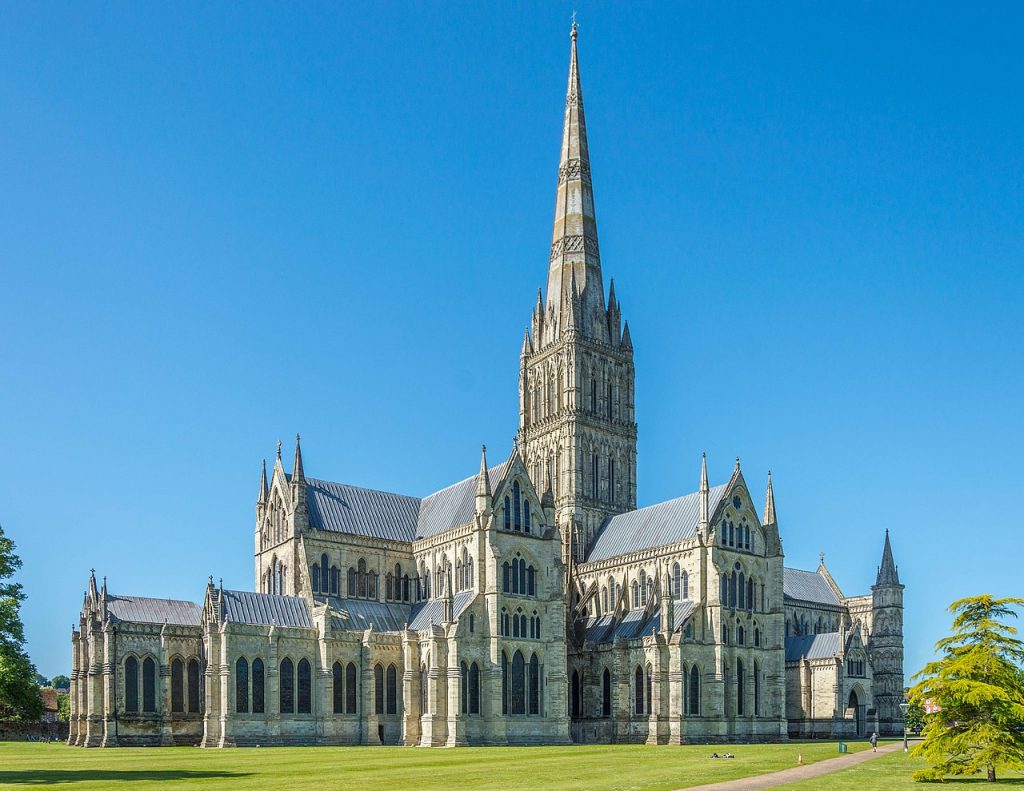
Salisbury Cathedral is known for its central spire, which towers 404 feet (123 m) over the surrounding town. The church also has a vast green space surrounding it on all sides; this open area is known as the “Cathedral Close.” Today, modern photographers are able to take photos showing the church in its entirety, thanks to this open space. Unlike many other Gothic Cathedrals, Salisbury Cathedral was built in one cohesive style, making it one of the best examples of Early Gothic Architecture in the United Kingdom. The church’s stained glass windows are also some of the finest to have survived from the Middle Ages.

At the beginning of the middle ages in 1066 CE, England was invaded by the Normans under the leadership of William the Conquerer. Read our article, “Norman Architecture and the Top 15 Norman Buildings” to learn more!
16. Jerónimos Monastery – Lisbon, Portugal

Jerónimos Monastery is located in the area of Lisbon known as Belém. The monastery sits on the spot of a much older church that was frequently used by sailors and their families to pray for safe travels at sea. This connection with the ocean and with seafaring can be seen in the architecture of the Monastery. Various symbols such as anchors, rope, knots, and sailing instruments, can be seen in its ornamentation. This unique characteristic is only found within Portugal, giving rise to the term Manueline Gothic, named for King Manuel I.
17. Reims Cathedral – Reims, Grand Est, France
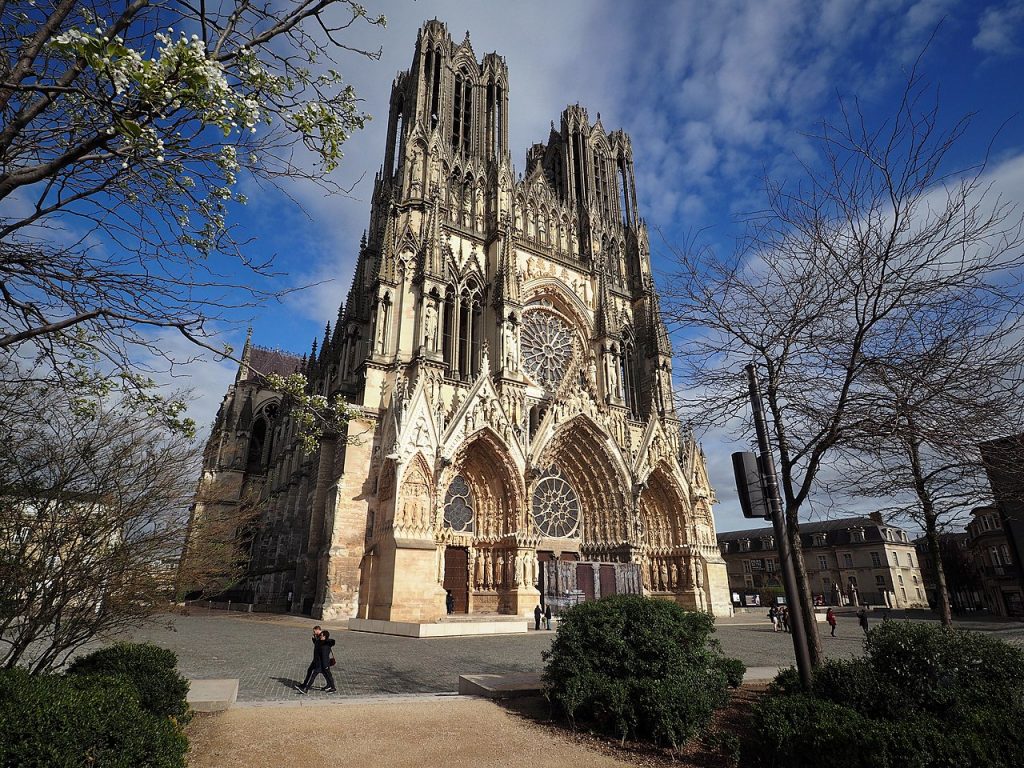
France contains several of the world’s greatest Gothic Cathedrals. In fact, nearly every large French city feature some sort of Gothic Church. Reims, a city 90 miles (144 km) by car from Paris, is famous for its cathedral which was built from the 13th-15th century. Notre-Dame de Reims’ front elevation is known for its symmetry and the massive window above the central door. The Cathedral was heavily damaged during a bombardment in WWI, when the roof completely collapsed and much of the original stonework was damaged. But today, after a massive restoration project, Reims Cathedral is back to the way it was at the height of the Gothic Age.
18. Westminster Abbey – London, England, United Kingdom

Located within Westminster, an inner borough of England’s capital city London, Westminster Abbey is one of the most iconic buildings in all of the United Kingdom. Although the foundations are much older, construction of the current building began in 1245 and was finished by the end of the 14th century. The towers were the final element to be added to the building, they date to the 18th century. Westminster Abbey is the official site for many royal ceremonies, including the coronations of the British Monarchs.
19. Doge’s Palace – Venice, Veneto, Italy

During the Gothic Era, The Republic of Venice was a growing power in the Eastern Mediterranean, controlling parts of modern-day Croatia, Crete, and Several Islands in the Aegean Sea. The elected leader of the Republic of Venice was known as the Doge. The Doge’s Palace was the home for these rulers, and the distinct design of the building is a fantastic example of the Venetian Gothic Style. Like so many buildings in Venice, the palace is right at the water’s edge. The lagoon-facing elevation is completely symmetrical and has a colonnade at the first floor complete with pointed arches. The Doge’s Palace is also directly adjacent to two of Venice’s other main attractions, Saint Mark’s Basilica and Piazza San Marco.
20. Canterbury Cathedral – Canterbury, England, United Kingdom
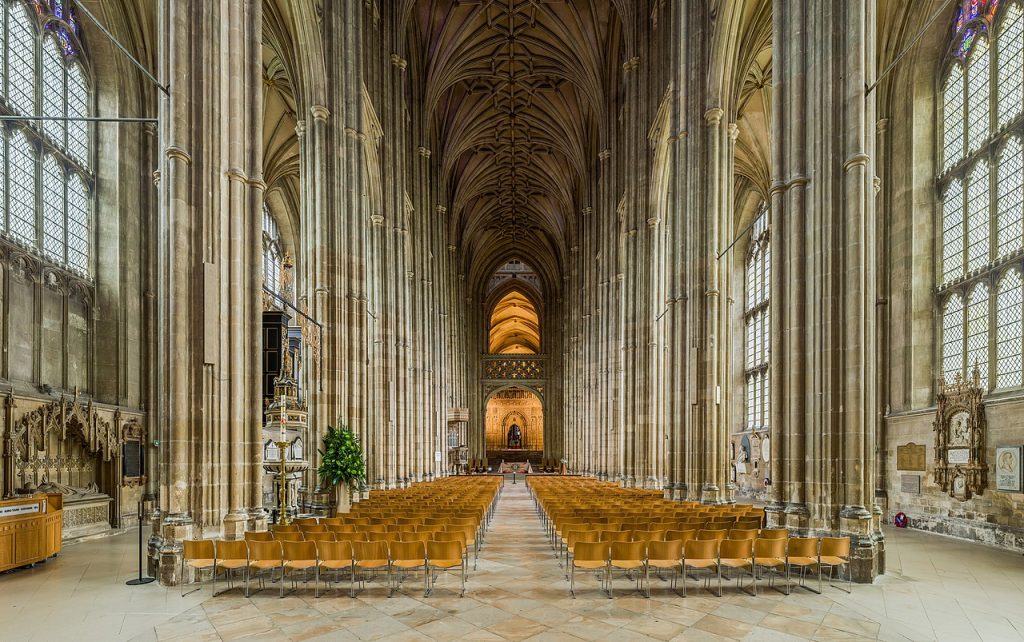
Canterbury Cathedral is one of the most important religious sites in all of England. Canterbury was once the seat of the country’s highest religious authority. The church was built and modified over the course of history, starting off as a small Romanesque Chapel in the 6th century. Construction started on the current church in 1174 after a fire destroyed much of the original building. In 1170, the Archbishop of Canterbury Thomas Becket was murdered within the church after a dispute with the King of England. After his death, a shrine was built in his honor which was visited by many. Eventually, to accommodate all of the pilgrims visiting the shrine, the cathedral was greatly enlarged. Thomas Becket was later canonized by the Pope, and thousands of visitors still come to Canterbury Cathedral every year to commemorate him.
21. Orvieto Cathedral – Orvieto, Umbria, Italy
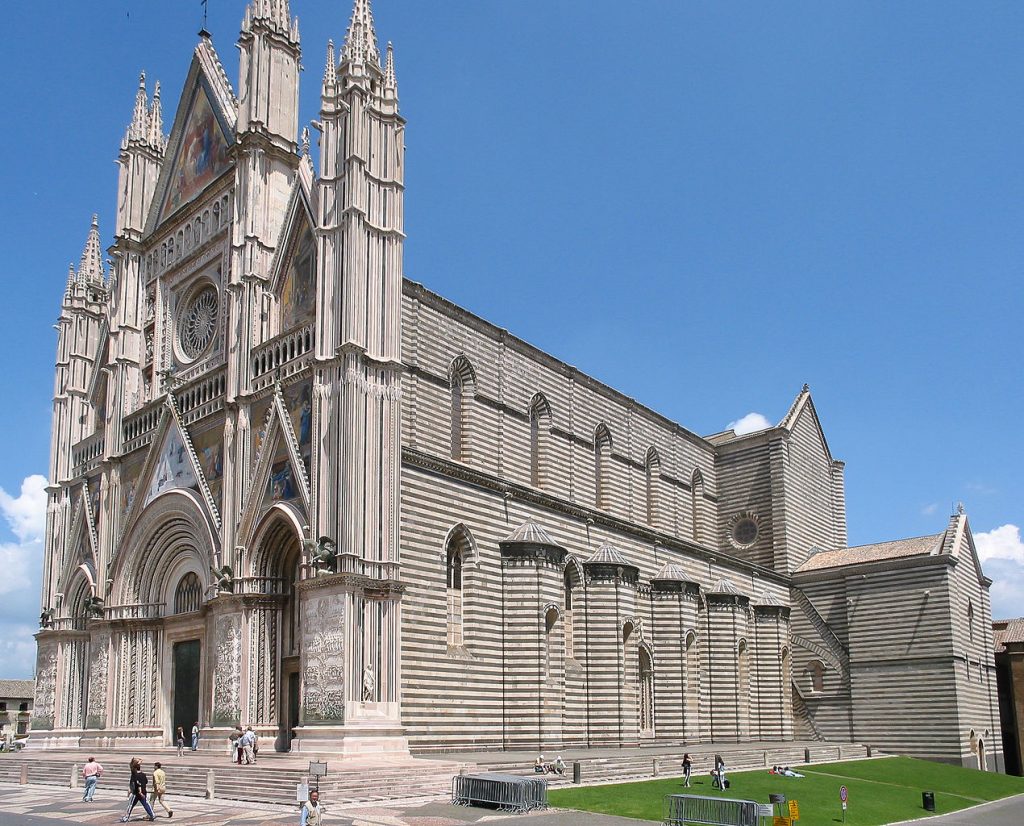
Orvieto is a city in Italy, about 90 minutes by car from the Italian Capital, Rome. Its close proximity to the Vatican made it a great location for the Catholic Popes to hide out during turbulent times back in Rome. Starting with Pope Urban IV in the early 13th century, Orvieto became the Pope’s home-away-from-home, complete with a huge palace. Thanks in large part to the city’s connection with the Pope, Orvieto contains one of the best examples of Italian Gothic Architecture. The Cathedral of Orvieto is also known for the many different frescoes that decorate the interior and the front facade of the building. These frescoes, some painted by renowned Italian artist Luca Signorelli, are some of the church’s most iconic features.
22. Barcelona Cathedral – Barcelona, Catalonia, Spain
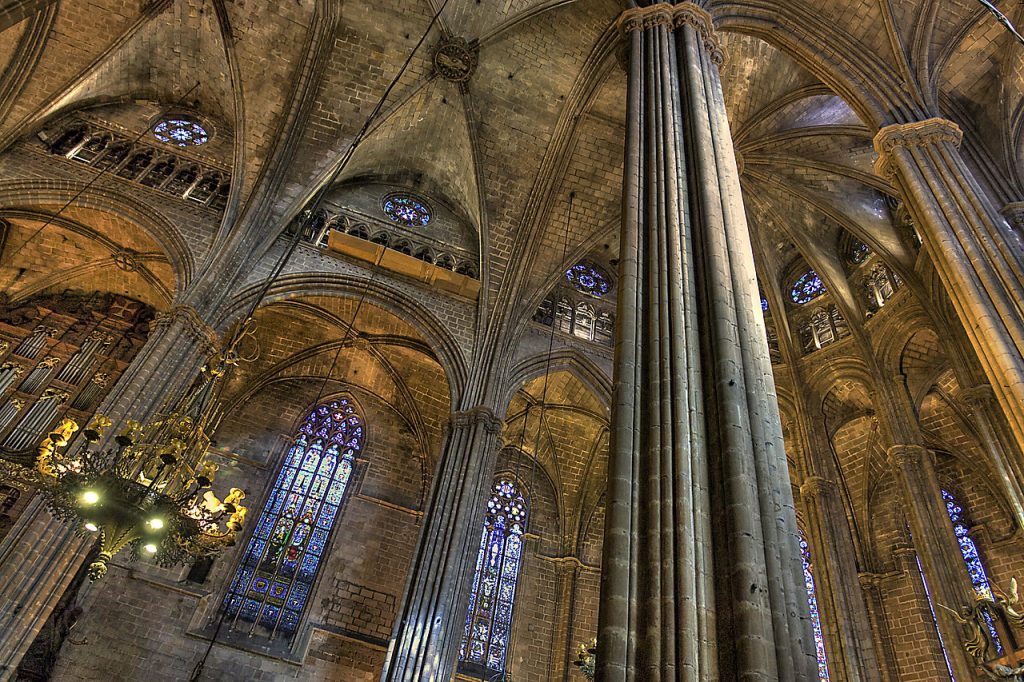
Barcelona, the historic capital of the region of Catalonia, is one of Europe’s most visited cities. Its medieval neighborhood is known as the Gothic Quarter, thanks to its plethora of Gothic Buildings. Barcelona Cathedral was constructed from 1298-1448. The three towers on the front facade are a unique feature, these face Barcelona’s modern Plaça Nova, a popular square within the city. Although Barcelona’s most famous church is of course, Antoni Gaudí’s masterpiece, the Sagrada Familia, the Cathedral of Barcelona is a close second, and it represents the city’s powerful medieval legacy.
23. Brussels Town Hall – Brussels, Belgium

The Town Hall in Brussels, Belgium is one of the greatest examples of Gothic Architecture used in a municipal building. It was built from 1401-1455, during a high point in the city’s history. The town hall is located on the western side of the Grand Place, one of Europe’s more well-known squares. Miraculously, the majority of the stone exterior of the building survived an attack by a French army in 1695. The French, bombarded the entire area around the Grand Place, firing cannons and other mortars continuously for several hours. Almost nothing remained after the attack, but over time, the buildings of the square were rebuilt and the town hall was completely repaired. Today, the Town Hall of Brussels has inspired many other works of architecture, including the Brussels City Museum, which is located right across the square.
24. León Cathedral – León, Castile and León, Spain
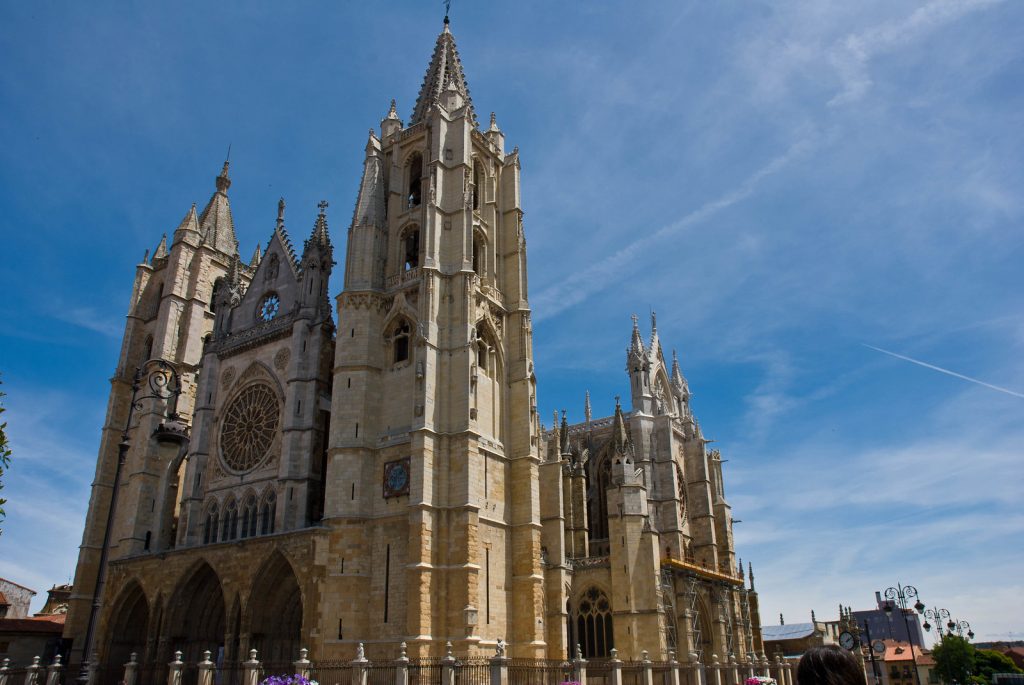
León is a city located in northern Spain and was once the capital of the powerful Kingdom of León. Construction of the cathedral started in the final stages of the Kingdom of León in the early 1200s. In 1230, Ferdinand III of Castile claimed the throne of León for himself, and it was absorbed into the Kingdom of Castile. After 1230, the Castilians continued building the church, and construction was mostly completed by the start of the 14th century. Later on, in the 15th century, a cloister and a second bell tower were added. The cathedral is well known for its representation of the Early Gothic Style. It has a much more simplified form and isn’t completely covered with detailed stonework and statues, like many other late Gothic Churches.
25. Llotja de la Seda – Valencia, Spain

Translating to the “Silk Exchange”, Llotja de la Seda was a commercial building where merchants and traders met to exchange goods. It is one of the greatest examples of Gothic Architecture in the region of Valencia, which shows the immense wealth that trade brought to the city. The most iconic room within the Silk Exchange is the Sala de Contratacion, or “The Contract Hall.” The twisting spiralized columns are a marvel of masonry sculpture. They are thin and elegant but still manage to take the immense weight of the vaulted stone ceiling above.

Valencia is one of Spain’s many incredible cities. It contains incredible works of architecture front the Gothic, Renaissance, and Baroque Ages. Read our article “Architecture of Valencia” to learn more!
Gothic Revival Architecture
Although the Gothic Age ended around the same time as the Middle Ages, the spirit of Gothic Architecture is still seen in many modern buildings. Gothic Revival is an architectural style that was popular in the late 19th century. Many buildings were designed in this style, including the Parliament Building in Budapest, Hungary. Even though it doesn’t date from the Gothic Age, all of the building’s features are distinctly Gothic. You can see many of the trademark elements, such as pointed arches, stained glass, and buttresses.
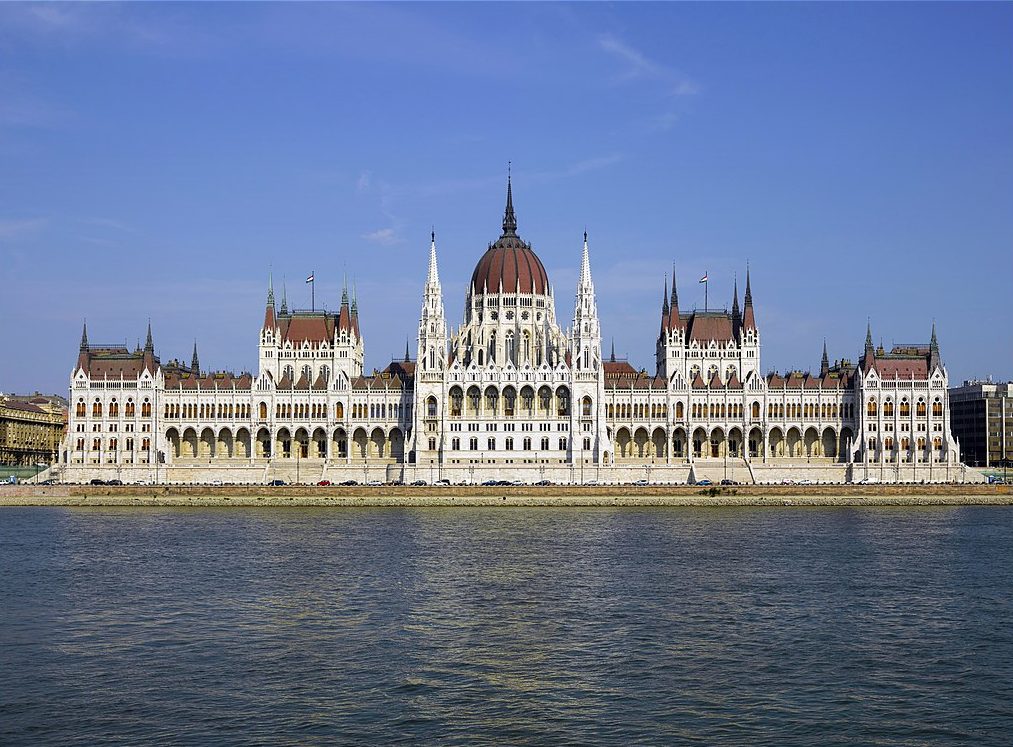
In the German city of Munich, when city officials had to build a new town hall in the 19th century, they decided to go with a Neo-Gothic Design. The relatively modern building fits in with the medieval architecture in the Bavarian Capital. The New Town Hall in Munich also borrowed elements from the town hall in Brussels Belgium, one of the greatest examples of Gothic Architecture in a municipal building.

Legacy of Gothic Architecture
Gothic Architecture was one of the first unifying styles in European History. The Gothic Style utilized new technologies like pointed arches and flying buttresses to create buildings that soared to unheard-of heights. Gothic buildings were designed to inspire the deeply religious populations of Medieval Europe. Many of the world’s largest and most impressive Cathedrals date to the Gothic Age, and many cities throughout the continent are built around these monuments. Gothic Architecture also saw a resurgence during the 19th-Century Revival Movement, and examples of the Gothic Style can be found throughout the entire world.
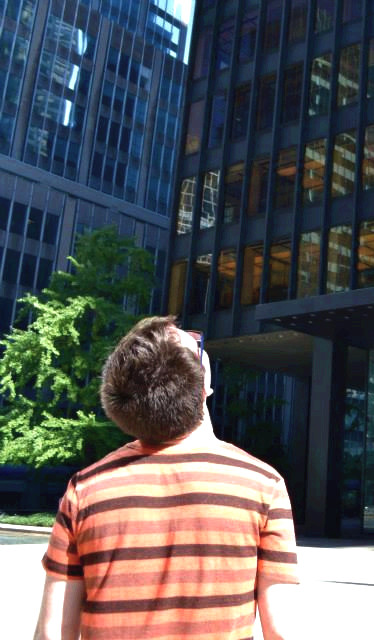
- About the Author
- Rob Carney, the founder and lead writer for Architecture of Cities has been studying the history of architecture for over 15 years.
- He is an avid traveler and photographer, and he is passionate about buildings and building history.
- Rob has a B.S. and a Master’s degree in Architecture and has worked as an architect and engineer in the Boston area for 10 years.
Like Architecture of Cities? Sign up for our mailing list to get updates on our latest articles and other information related to Architectural History.

Photo by Gary Ullah from Wikimedia Commons
